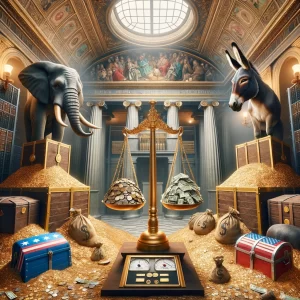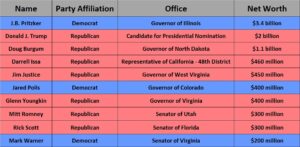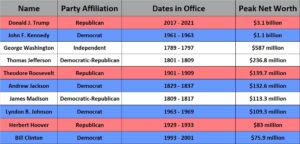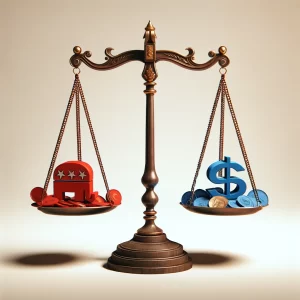
Without a doubt, finances shape the landscape of American politics. However, the financial muscle behind each party has long been a subject of intense scrutiny and debate. So when it comes down to the dollar and cents of it, who is richer, Democrats or Republicans?
The Financial Divide: an Overview
The financial landscape of American politics is as diverse as its electorate. There are significant variances in wealth among the members and supporters of both parties. Contrary to popular belief, the distribution of wealth does not strictly align with party lines. Historical data and recent studies have shown surprising trends, with increasing wealth on both sides of the aisle.
While Republicans have traditionally been seen as the party of affluence, Democrats are not far behind. A quick comparison will reveal that both parties have numerous members with impressive net worths within their ranks.
Who Are the Richest American Politicians?
The answer to this question largely depends on the context which you view it from. Therefore, we are going to look at historical facts and figures to offer the broadest view.
Current Politicians
Based on current data compiled by Visual Capitalist and GOBankingRates, this is the top 10 list of current politicians that have the greatest net worth. To qualify for this list, the individual must currently hold a state or federal office. However, it also considers individuals who are currently running for these positions as well.
As you can see from this data, Republicans dominate the top 10. However, it is interesting to note that more than half of all Congressional members are millionaires. While the average net worth is also above $1 million, much of the wealth is concentrated in the top 10% of its members.
The Richest U.S. Presidents
Taking another view of the financial debate, 24/7 Wall Street analyzed historical data for each of the American presidents. Wealth and social connections have helped many politicians achieve their presidential dreams and maintain political dynasties. While not all presidents started life in the lap of luxury, many of them came from substantial wealth.
While the figures were adjusted to the inflation levels of December 2018, this table provides another interesting view of the fortunes and political affiliations of the men who led our country throughout its history. Their total net worth takes into account all their assets including real estate, inheritance, ownership of companies, savings, profits from family estates, royalties, and other sources of income.
This list shows much greater diversity within its ranks and more even distribution across current and former political parties.
Which Party is the Party of the 1 Percent?
Although decision-makers in Congress and the White House play a significant role in national politics, you cannot ignore the impact of wealth on politics. The financial clout of a party impacts its policy priorities, campaign strategies, and legislative agendas. Wealthy party members and politicians can wield considerable power by shaping national discourse and influencing decisions. Therefore, the wealth of party supporters is another critical aspect of this discussion.
While stereotypes often paint Republicans as the wealthy elite, Democrats are hardly all members of the working class. The reality is much more nuanced, with both parties boasting supporters across the political spectrum. Even if you try to determine party affiliations from the Forbes list of the wealthiest Americans, you will quickly discover that many of them contribute to candidates and Super PACs from both parties. Even those who present themselves as centrist or social liberals tend towards fiscal conservatism when you track their political contributions.
While some billionaires such as George Soros and Rupert Murdoch have been very vocal about their political leanings and contributions in public forums, most prefer to exert their influence in other ways. Many engage in “stealth politics” by remaining behind the scenes to help shape national policy. By staying out of the limelight and public debates, they can avoid criticism and debate while funding the candidates and organizations that support their agenda.
Who Gets More Funding: Democrats or Republicans?
First, both parties receive substantial support. During the 2024 election cycle, six committees associated with the parties reported that they have raised a combined total of $572 million so far. In a side-by-side comparison, Democrats come out ahead when it comes to official fundraising for their campaigns. They are currently holding more than $315 million while the Republican party has only accrued about $257 million. But, there is still a long road ahead until election day.
Much of it comes from registered voters who make $100K+ annually. However, in past elections, the majority of funds came from a small group of private donors. And, this doesn’t account for outside spending which is not used by the candidates or reported to the Federal Election Committee. Furthermore, Super Political Action Committees (Super PACs) can contribute unlimited funds to influence elections and legislation. These entities often reflect the interests of the wealthiest individuals and corporations. And if you look at which Super PACs the billionaires have backed in the past, their continued support would shift the scales in the Republicans’ favor.
Democrats or Republicans: Who Has the Higher Income?
In the end, the question of which party is richer has no straightforward answers. Both sides have vast financial resources and wealthy supporters who bolster their political agendas.
Even at the household level, there are complex factors that affect income such as geography, education level, profession, age, gender, and ethnicity. While some studies and surveys suggest that Republican-leaning suburban areas have higher incomes, others that focus on Democratic-leaning urban centers indicate something different. Since findings can be skewed, it is also important to look at the methodology and definitions used before accepting something as a hard fact.
The truth is that the traditional assumptions about each political party no longer exist. Wealth is increasing on both sides as economic trends continue to change the demographic and economic conditions of party supporters.
Read More:
- The Billionaire President: How Trump’s Wealth Influences His Politics
- 12 Factors Influencing Biden’s Re-election Prospects in 2024

Jenny Smedra is an avid world traveler, ESL teacher, former archaeologist, and freelance writer. Choosing a life abroad had strengthened her commitment to finding ways to bring people together across language and cultural barriers. While most of her time is dedicated to either working with children, she also enjoys good friends, good food, and new adventures.












